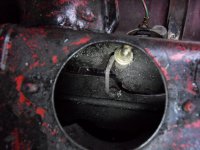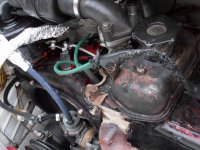Used the 500 at the weekend as the sun was out and the roof folded back. I had a 4ft sheet of wood to move and some large bags of rubbish to take to the tip and a large gas cylinder to get refilled. Yes....it all went in.
The problems started on the way back. Each time I stopped and had to restart the engine it wouldn't start without several minutes cranking with my foot hard on the throttle. I'm guessing fuel evaporation as the engine bay was very hot. I have the 28imb carby and generator, and the two (unshielded) fuel pipes fun above the throttle linkage/below the inlet pipe. Is there a better/correct routing or do I go for shielding?
I alos noticed that the ingnition leads had dropped onto the rocker cover and the black shielding was melting. The two brackets/grommets don't seem able to keep the leads in mid air (they get hot and flop), so I may have to build a support/bridge.
Most concerning was the oil pressure light which came on unless the engine was revved. Oil is 20W50 mineral, so should be thick enough and is upto the full mark on the dipstick. My guess is the oil pump is a worn and outside tolerance or the pickup has a leak somewhere, but before I go into spanner mode, is there any collective wisdom?
The engine bay does get very hot - i'm thinking of making up some standoffs to hold the lid open by a few inches - anyone tried this and does it make any difference? We had a thread about exhaust wrap - I'm still thinking these used to run in Italy, which is a warm country, so I must be missing something on all of the above.
These annoyances are limiting my use of the 500 as I don't trust it - need to get them resolved.
Cheers in advance.
John
The problems started on the way back. Each time I stopped and had to restart the engine it wouldn't start without several minutes cranking with my foot hard on the throttle. I'm guessing fuel evaporation as the engine bay was very hot. I have the 28imb carby and generator, and the two (unshielded) fuel pipes fun above the throttle linkage/below the inlet pipe. Is there a better/correct routing or do I go for shielding?
I alos noticed that the ingnition leads had dropped onto the rocker cover and the black shielding was melting. The two brackets/grommets don't seem able to keep the leads in mid air (they get hot and flop), so I may have to build a support/bridge.
Most concerning was the oil pressure light which came on unless the engine was revved. Oil is 20W50 mineral, so should be thick enough and is upto the full mark on the dipstick. My guess is the oil pump is a worn and outside tolerance or the pickup has a leak somewhere, but before I go into spanner mode, is there any collective wisdom?
The engine bay does get very hot - i'm thinking of making up some standoffs to hold the lid open by a few inches - anyone tried this and does it make any difference? We had a thread about exhaust wrap - I'm still thinking these used to run in Italy, which is a warm country, so I must be missing something on all of the above.
These annoyances are limiting my use of the 500 as I don't trust it - need to get them resolved.
Cheers in advance.
John





